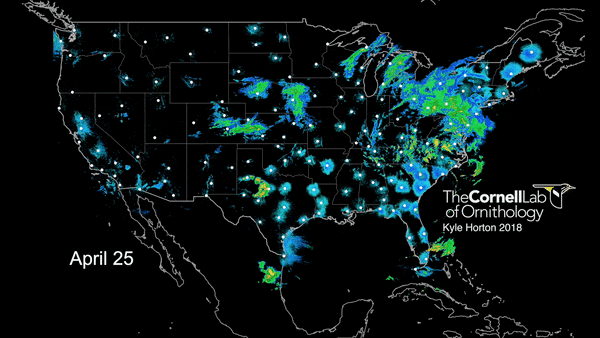Creating a Continental Bird Migration Forecast
Researchers predict the movements of millions of birds across the United States
Ithaca, N.Y. & Oxford, U.K.—September is the peak of autumn bird migration, and billions of birds are winging their way south in dramatic pulses. A new study published in the journal Science reports that scientists can now reliably predict these waves of bird migration up to seven days in advance. The study details the underlying methods that power migration forecasts, which can be used as a bird conservation tool.
"Most of our songbirds migrate at night, and they pay close attention to the weather," says study lead author Benjamin Van Doren, a Ph.D. student at the University of Oxford and a Cornell University graduate. "Our model converts weather forecasts into bird migration forecasts for the continental United States."
In this study, the researchers quantified 23 years of spring bird migration across the United States using 143 weather radars, highly sensitive sensors that scientists can use to monitor bird movements. They filtered out precipitation and trained a machine learning model to associate atmospheric conditions with levels of bird migration countrywide. Eighty percent of variation in bird migration intensity was explained by the model.
 |
|
The radar loop above depicts bird migration during spring 2018. Animation by Kyle Horton, Cornell Lab of Ornithology. Download the MP4 animation.
|
"The capacity to forecast where and when birds are likely to be flying is instrumental for conservation goals," says co-author Kyle Horton, a Rose Postdoctoral Fellow at the Cornell Lab of Ornithology.
Migration forecasts make it possible to reduce human-made threats to migratory birds during a journey that is already fraught with danger. In addition to the energy-depleting journey itself, birds may be thrown off schedule when they become disoriented by city lights. They may crash into tall buildings, cell towers, or power lines. Loss of habitat along their route could mean they don’t have the energy to complete the trip on time or may arrive on their breeding grounds in poor condition, making them unable to breed at all.
In addition to predicting pulses of intense migration, Van Doren and Horton also used the model to estimate nightly migratory movements across the entire country. During peak migration in early May, they say often more than 420 million birds pass overhead each night.
"We used 12 variables to model the distribution of migratory birds across the continent," explains Van Doren. "Temperature was the most important variable. Migration intensity was greatest on warm nights, probably because warm temperatures generally bring favorable winds and the emergence of leaves and insects."
The first migration forecast maps based on this research were released to the public earlier this year on the Cornell Lab’s BirdCast website (birdcast.info), where they are updated every six hours. In addition to maps that predict bird movements up to three days ahead, the site also features real-time bird movements based on current weather radar.
"Radars have been illuminating the movement of birds for nearly 75 years—there are still integral discoveries to be made," notes Horton. "With migration coming into full swing, we’re excited to deliver autumn forecasts for the first time."
Reference:
Benjamin M. Van Doren and Kyle G. Horton. A continental system for forecasting bird migration. Science. September 2018. DOI 10.1126/science.aat7526.
###
Editors: Images or artwork appearing in this news release are cleared for use with this story and must appear with the credit provided. Additional material for download.
Media Contact:
Pat Leonard, Cornell Lab of Ornithology, (607) 254-2137, pel27@cornell.edu
|